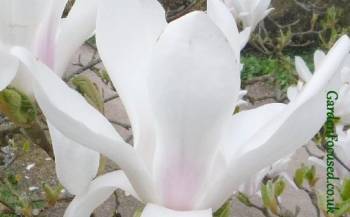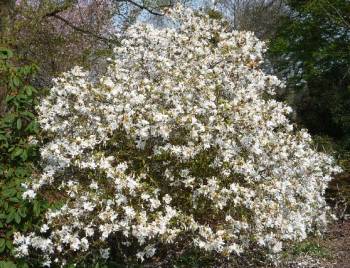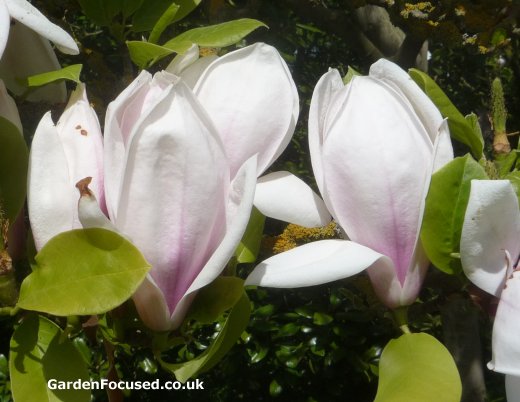MAGNOLIAS FOR THE UK
Article by David Marks
Magnolias can be evergreen or deciduous but the deciduous varieties (loose their leaves in winter)are far more common in the UK. The reason is that they produce flowers when they have few leavesand this allows the beauty of the flowers to be seen much more clearly.
They are one of the oldest plant groups still in existence today and date back at least 20million years with some related plants dating back 95 million years.
Magnolias evolved well beforebees did and evolution has formed them so that they encourage pollination by beetles and not bees or moths.This greatly increases their chance of successful pollination. Bees do visit them but normally too late in the yearfor successful pollination.
The cultivation of magnolias in gardens dates back at least to 600 AD, records showing that they were popular in large Chinesegardens. Magnolias are named after the French botanist Pierre Magnol although the original plantwhich took his name was not in fact a magnolia. It was William Sherard who correctly attributed the name tothe magnolia species.

Use the checklist below to work out if a magnolia is suited to your garden.
- They prefer full sun throughout the year but will also grow well in light shade for part of theday. Inlow light conditions the plant may not produce flowers.
- Some varieties are well suited to growing in containers.
- Different varieties range from a height 2.5m / 8ft and spread 2.5m / 8ft up to 20m /63ft heightand spread. Choose your variety according to the space you have.
- They grow best in soil which is slightly acidic or neutral, they do not do well in alkaline,chalky soils. See here for more information aboutacid and alkaline soil.
- They are shallow rooting plants and because of this the soil should not be allowed to dry out.An annual mulch is highly recommended to prevent water loss.
- Magnolias tolerate neglect well (aside form an annual mulch) when they are established because their nutrient requirementsare low and they grow well with minimal pruning.
- All produce flowers and the most common ones do this for a couple of weeks (depending greatlyon local weather conditions) in late March to late May.
- They should not be planted in frost pockets or areas that are subject to water-logging.
- They rarely suffer from pests or diseases unless completely neglected.
- They need to be planted in a fairly protected position. Wind will not only exaggerate theeffect of frost but can also damage the branches.
PLANTING A NEW MAGNOLIA
First identify the correct position. In full sun and not directly open to northerly andeasterly winds is best and not in a place which will get waterlogged. As far as spacing isconcerned, don’t cramp your magnolia and allow enough space for it to grow to its full size. Theplant label should give a good idea of spacing but in the absence of that the following roughguidelines for mature plants can be used:
- Magnolia ‘Elizabeth’ – height 10m / 32ft, spread 6m / 19ft.
- Magnolia ‘Jane’ – height 4m / 13ft, spread 3m / 10ft
- Magnolia loebneri – height 8m / 25ft, spread 6m / 20ft.
- Magnolia soulangeana – height 7m / 22ft, spread 7m / 22ft.
- Magnolia stellata – height 2.5m / 8ft, spread 2.5m / 8ft.
- Magnolia ‘Susan’ – height 3m / 10ft, spread 3m / 10ft.
The best time to plant a deciduous (looses its leaves in winter) magnolia is when they aredormant, from December to January. Dig the soil well slightly deeper than the container of the newplant and 60cm to 90cm wide. Remove the plant from the container and place the plant in the hole tothe same depth it was in the pot and fill in around it with the dug earth.
Do not pile the soil higher around the base of the plant, the roots of magnolias are shallow bynature. Water well and make sure the area around the plant remains moist for the next nine monthsuntil the roots have established themselves.

Magnolia George Henry Kern flower
HOW TO CARE FOR A MAGNOLIA
When magnolias are established they are truly low maintenance shrubs. The following care plan will help them thrive although they withstand neglect (other than lack of water) very well:
- An annual mulch with well-rottedorganic matter such as the compost heap or spent potting compost.
- Weed well around the base of the plant and keep mulches away from the stem.
- If your garden soil gets dry in summer water very well a couple of times during the dry period.Magnolia roots are shallow and even well-established they can dry out in summer.
PRUNING MAGNOLIAS
Pruning a magnolia will not damage it but it will encourage the growth of wispy shoots whichdetract from the shape of the plant. Pruning can also cause flowering to reduce for a couple ofyears. So, the rule with magnolias is to avoid pruning them unless they are outgrowing theirexisting space. The best time to prune a magnolia is early to mid summer because this will avoidthe cuts bleeding which can be an easy site for infection.
- Spread any pruning out over at least two and preferably three years
- Prune out crossing and diseased branches first
- Aim to keep the centre of the magnolia open
- Prune branches back to a main stem
GROWING MAGNOLIAS IN CONTAINERS
Some Magnolias will grow very well in large containers and our advice is to choose varieties ofMagnolia stellata. They are naturally smaller compared to other magnolias and the container willrestrict their size even more.
BEST CONTAINER FOR A MAGNOLIA
Stone or terracotta are best for a couple of reasons. First and most importantly, their weight (compared tolighter containers) will help prevent them from being blown over in strong winds. Choosecontainers with a base that is wide enough to stand well.
Wood containers look very attractive and they also have substantial weight. However they may wellrequire treatment to prevent the wood from decaying and the treatment maydamage your Magnolia. Make sure any container you use has good drainage holes in the base.
Avoid bulbous, rounded pots where the top is narrower than the middle or base because when thetime does come for re-potting the only way to remove your Magnolia will be by breaking thecontainer.
The size of pot should be appropriate for the size of the bush. Simplylooking at the pot size in relationship to the tree size is normallyenough to allow selection of the correct size of container. However,as an example a 45cm (18in) square pot supports our 140cm high magnolia very well.
WHEN AND HOW TO RE-POT A MAGNOLIA
When you buy your Magnolia it may require immediatere-planting or after several years it may outgrow the existingcontainer. The best time of year to re-plant a Magnolia treeis in late winter to early spring. First select a new container asdescribed above.
The next decision is which soil to use. Magnolias prefer aslightly acidic soil so potting compost for Rhododendrons, Azaleasor ericaceous plants is suitable. Another solution is to use a loambased compost which is slightly acidic. John Innes sell their ownericaceous mix which is an ideal choice especially if about 20% ofsharp (not builders) sand is mixed in.
If the container haspreviously been used then scrub it clean of all the old soilresidue. Add about 4cm (1½in) of smallish stones / broken pot piecesinto the base of the container – this will help to ensure gooddrainage.
Remove the tree from its old container and lightly brush awaysome of the compost from the root ball and the surface. Be careful not not to damage the rootsbecause they can easily break. Add some new compost into the container and then transfer themagnolia onto the compost.
It will be necessary to add or remove some compost to ensure thatwhen more compost is added it comes to the same level around themain stem as it was in the old container. Add new compost, a fewcentimetres depth at a time, and lightly firm it down. Don’t compactthe new compost but do ensure there are no air-pockets in it.
Fill up with compost to about 5cm / 2in from the top ofthe container. Add about 2cm / ¾in of chippings to the surface ofthe compost. It is well worth buying a bag of chippings whichfinishes off the surface nicely as well as deterring weeds and pests.
Water well with rain water (rather than tap water) ifpossible. It is also a good idea to buy container supports whichwill keep it off the ground. This ensures the best possible drainageand stops the base of the container becoming a home for all mannerof insects and bugs.
CARE OF MAGNOLIAS IN CONTAINERS
Magnolias growing in containers need only minimal care butthey do appreciate it frequently. The first rule is to try andmaintain a constant supply of water in the compost withoutover-watering. Even two or three days of warm, sunny weather withoutwatering can do them a lot of harm.
If you plan a holiday in the summer the ideal is to ask yourneighbour or friends to water your Magnolia(s). If that is notpossible then move them into a shaded and cool position. If yourarea suffers cold winters and or high winds then place your Magnolia in a cool greenhouse or garage from late December onwards andbring them back into the garden in early Spring.
Feeding with a general purpose fertiliser can commence from earlyMay at fortnightly intervals. Cease feeding in late July so that thetree has a chance to ‘harden up’ before winter.
An annual prune in early June should remove any damaged or wispystems particularly in the centre of the tree. Pruning can also bedone to maintain the shape and size of a Magnolia.
WINTER CARE OF MAGNOLIAS IN CONTAINERS
There are two principal considerations when looking after Magnolias in containers during the UK winter. The first is to prevent the soilfrom becoming water-logged by winter rain. As mentioned above,Magnolias are tolerant of many conditions but they do notappreciate large changes in the amount of water in a container.
The second factor to watch out for, as with all containerisedplants, is to avoid the soil freezing over long periods of time.Magnolias have a fleshy root system which is easily damagedby protracted periods of frost. It is possible to insulate thecontainers but this only delays the frost and when warmer weatherappears, an insulated container takes longer to defrost.
With the above two principals in mind our advice is to move your Magnolia into a more protected position during periods offrost in the winter. The ideal position would be in a coldgreenhouse. This will protect your tree from the cooling winds andgive some protection from frost. If you do this though, be sure toremove it from the greenhouse at the first sign of warmweather – greenhouses can become surprisingly hot very quickly inonly moderately warm weather.
Most of us don’t have greenhouses however so a good alternative is against the exterior wall ofa house. As with greenhouses,move the tree back into the open after the frosts have passed.
If you have neither a a greenhouse nor an open garage then do not betempted to move the tree inside the house. Conditions there will toowarm and the air too dry. The best option is to search out the mostprotected position near the walls of the house. House walls will berelatively warm in winter and can protect your Magnolia treefrom the worst of the frost. Also look for a position which protectsfrom wind and reduces the amount of rain that falls on the soil inthe container.
MAGNOLIA PESTS AND DISEASES
Once your magnolia is established you are unlikely to suffer any problems. The most likely oneshowever are:
SLUGS
Younger magnolias can be attacked by slugs which eat the more tender leaves. Slug pellets, some areorganic, and picking them off by hand are the key solutions. Once a magnolia gets past fiveyears they should be able to grow through a slug attack.
RABBITS
Rabbits can be attracted to the bark and once they find it they can easily eat through largeamounts with sometimes fatal consequences. Barrier protection, either spiral tubes round the lowerstems or a low level wire mesh fencing, is the only method of preventing damage.
YELLOWING LEAVES
If the leaves of your magnolia turn a pale yellow colour the most likely cause is a soil which istoo alkaline. This prevents the plant taking up essential nutrients. Feed the plant with afertiliser designed for ericaceous plants (rhododendrons, azaleas etc.). Mulch around the plantannually with an ericaceous compost.
WHERE TO BUY MAGNOLIAS
Magnolias are rather expensive shrubs to buy and it can pay to be aware of where good qualityplants can be bought. Our comparison below is based on plants growing inaverage conditions.
Overall we
recommend Crocus as your online supplier of Magnolias.
DIFFERENT VARIETIES OF MAGNOLIAS
Choosing a particular variety of magnolia for your garden is of course a matter of personalpreference but the list below will help identify commonly available varieties which will grow wellin your garden.
MAGNOLIA STELLATA
MATURE SIZE: height 2.5m / 8ft, spread 2.5m / 8ft
FLOWERING TIME: Late March to April
FLOWERS: Pure white, thin petals, lots of them, a slight scent
LEAVES: Mid green, shed in winter
FEATURES: Tolerates alkaline soil well, RHS Award of Garden Merit, grows well in containers
BUY ONLINE: The GardenFocused recommended supplier of Magnolia Stellatacan be found here.

Magnolia stellata in full flower

A single Magnolia stellata flower
MAGNOLIA SOULANGEANA
MATURE SIZE: height 7m / 22ft, spread 7m / 22ft
FLOWERING TIME: April to early May
FLOWERS: Large flowers shaped like tulips, white with a pink flush at the base, aslight scent
LEAVES: Mid green, shed in winter
FEATURES: Slightly later flowering than average so good for frost prone areas,size makes it a small tree, a magnificent display in spring.
BUY ONLINE: The GardenFocused recommended supplier of Magnolia Soulangeanacan be found here.

Magnolia Soulangeana
MAGNOLIA SUSAN
MATURE SIZE: height 3m / 10ft, spread 3m / 10ft
FLOWERING TIME: April to early May
FLOWERS: Mid purple when the buds form turning to a pale pink when in full bloom
LEAVES: Mid green, shed in winter
FEATURES: Can be container grown
BUY ONLINE: The GardenFocused recommended supplier of Magnolia Susancan be
found here.
MAGNOLIA SUMMARY
Below we list the key strengths and weaknesses of Magnolias.
| HARDY | |
| CLAY SOIL | Yes |
| SANDY SOIL | Yes |
| DRY SOIL | No |
| SHADE | No, partial, full sun |
| EVERGREEN | No |
| EASY CARE | |
| SMALL GARDENS | Some varieties |
| POT / CONTAINER | Some varieties |
| FLOWERING | |
| FLOWER TIME | April / May |